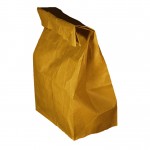 In today’s fast-paced world, we have limited time. Convenience foods have emerged to meet this demand. Many things we purchase come ready prepared and individually packaged. This may make things easier, but what is the real cost of convenience?
In today’s fast-paced world, we have limited time. Convenience foods have emerged to meet this demand. Many things we purchase come ready prepared and individually packaged. This may make things easier, but what is the real cost of convenience?
Packaging takes more resources and more energy than non-packaged food. Packaging also leads to more waste in landfills. For example, the average child taking a disposable lunch to school produces around 67 pounds of garbage in one school year! Packing waste free lunches helps schools and communities decrease the amount of waste they create.
Disposable packaging also has a negative effect on our wallets. A disposable lunch costs about $4.00; a similar waste free lunch costs only $2.65. This extra cost comes from the packaging itself and the increased price of prepared foods.
Waste free lunches are healthier for you and your family. Lunch can supply as much as a third of our total intake of nutrients for the day. Pre-packaged foods are often high in fat, sugar and salt, and tend to have fewer nutrients than non-packaged foods. Make your choices count when preparing lunches by including all four food groups and choosing foods that are less processed.
A waste free lunch does not have throw away packaging and produces no food waste. Here are some easy ways to pack a waste free lunch:
- Choose lunch carriers, containers and drink bottles that you can re-use, a cloth napkin, and stainless steel cutlery.
- Include items that come with their own packaging, such as oranges, bananas or hard-boiled eggs and items that can be purchased in bulk, such as fruit and nuts
- Prepare extra food the day before and use leftovers for lunches ” Pack lunches the night before to decrease your workload in the morning and make you rely less on packaged food.
- Put your child’s name on containers, lunch boxes, thermoses and reusable water bottles so they will make it home.
- If going out for lunch, bring your own reusable container to bring home any leftover food.
- Use Eating Well with Canada’s Food Guide to help plan lunches and meals.
Remember a healthy lunch includes foods from all of the four food groups. Waste free lunches are better for the environment, less expensive and healthier for you and your family. See https://zerowastecanada.ca/tag/waste-free-lunch-challenge/ for more ideas on making small changes for a positive effect on our environment and your health.
WRITTEN BY THE PUBLIC HEALTH NUTRITIONISTS OF SASKATCHEWAN AND SUPPORTED BY
Originator: Stephanie Kendel, Dietetic Intern
Editing Buddies: Kyla Golightly, Prince Albert Parkland Health Region; Victoria Jurgens, Prince Albert Parkland Health Region






